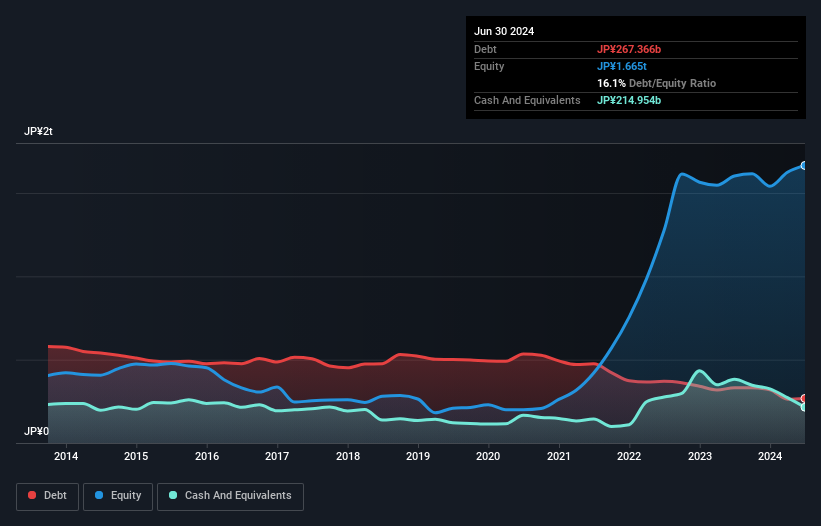- Japan
- /
- Marine and Shipping
- /
- TSE:9107
These 4 Measures Indicate That Kawasaki Kisen Kaisha (TSE:9107) Is Using Debt Safely

Legendary fund manager Li Lu (who Charlie Munger backed) once said, 'The biggest investment risk is not the volatility of prices, but whether you will suffer a permanent loss of capital.' When we think about how risky a company is, we always like to look at its use of debt, since debt overload can lead to ruin. We can see that Kawasaki Kisen Kaisha, Ltd. (TSE:9107) does use debt in its business. But should shareholders be worried about its use of debt?
Why Does Debt Bring Risk?
Debt is a tool to help businesses grow, but if a business is incapable of paying off its lenders, then it exists at their mercy. If things get really bad, the lenders can take control of the business. However, a more common (but still painful) scenario is that it has to raise new equity capital at a low price, thus permanently diluting shareholders. Of course, debt can be an important tool in businesses, particularly capital heavy businesses. The first step when considering a company's debt levels is to consider its cash and debt together.
View our latest analysis for Kawasaki Kisen Kaisha
How Much Debt Does Kawasaki Kisen Kaisha Carry?
You can click the graphic below for the historical numbers, but it shows that Kawasaki Kisen Kaisha had JP¥267.4b of debt in June 2024, down from JP¥331.7b, one year before. However, it does have JP¥215.0b in cash offsetting this, leading to net debt of about JP¥52.4b.

How Healthy Is Kawasaki Kisen Kaisha's Balance Sheet?
According to the last reported balance sheet, Kawasaki Kisen Kaisha had liabilities of JP¥193.6b due within 12 months, and liabilities of JP¥287.1b due beyond 12 months. Offsetting this, it had JP¥215.0b in cash and JP¥130.6b in receivables that were due within 12 months. So its liabilities outweigh the sum of its cash and (near-term) receivables by JP¥135.1b.
Since publicly traded Kawasaki Kisen Kaisha shares are worth a total of JP¥1.38t, it seems unlikely that this level of liabilities would be a major threat. But there are sufficient liabilities that we would certainly recommend shareholders continue to monitor the balance sheet, going forward.
We use two main ratios to inform us about debt levels relative to earnings. The first is net debt divided by earnings before interest, tax, depreciation, and amortization (EBITDA), while the second is how many times its earnings before interest and tax (EBIT) covers its interest expense (or its interest cover, for short). Thus we consider debt relative to earnings both with and without depreciation and amortization expenses.
Kawasaki Kisen Kaisha has a low net debt to EBITDA ratio of only 0.37. And its EBIT easily covers its interest expense, being 66.5 times the size. So we're pretty relaxed about its super-conservative use of debt. Also positive, Kawasaki Kisen Kaisha grew its EBIT by 20% in the last year, and that should make it easier to pay down debt, going forward. When analysing debt levels, the balance sheet is the obvious place to start. But ultimately the future profitability of the business will decide if Kawasaki Kisen Kaisha can strengthen its balance sheet over time. So if you want to see what the professionals think, you might find this free report on analyst profit forecasts to be interesting.
But our final consideration is also important, because a company cannot pay debt with paper profits; it needs cold hard cash. So the logical step is to look at the proportion of that EBIT that is matched by actual free cash flow. Over the last three years, Kawasaki Kisen Kaisha actually produced more free cash flow than EBIT. There's nothing better than incoming cash when it comes to staying in your lenders' good graces.
Our View
Happily, Kawasaki Kisen Kaisha's impressive interest cover implies it has the upper hand on its debt. And that's just the beginning of the good news since its conversion of EBIT to free cash flow is also very heartening. Considering this range of factors, it seems to us that Kawasaki Kisen Kaisha is quite prudent with its debt, and the risks seem well managed. So we're not worried about the use of a little leverage on the balance sheet. The balance sheet is clearly the area to focus on when you are analysing debt. However, not all investment risk resides within the balance sheet - far from it. To that end, you should learn about the 4 warning signs we've spotted with Kawasaki Kisen Kaisha (including 2 which shouldn't be ignored) .
Of course, if you're the type of investor who prefers buying stocks without the burden of debt, then don't hesitate to discover our exclusive list of net cash growth stocks, today.
Valuation is complex, but we're here to simplify it.
Discover if Kawasaki Kisen Kaisha might be undervalued or overvalued with our detailed analysis, featuring fair value estimates, potential risks, dividends, insider trades, and its financial condition.
Access Free AnalysisHave feedback on this article? Concerned about the content? Get in touch with us directly. Alternatively, email editorial-team (at) simplywallst.com.
This article by Simply Wall St is general in nature. We provide commentary based on historical data and analyst forecasts only using an unbiased methodology and our articles are not intended to be financial advice. It does not constitute a recommendation to buy or sell any stock, and does not take account of your objectives, or your financial situation. We aim to bring you long-term focused analysis driven by fundamental data. Note that our analysis may not factor in the latest price-sensitive company announcements or qualitative material. Simply Wall St has no position in any stocks mentioned.
About TSE:9107
Kawasaki Kisen Kaisha
Provides marine, land, and air transportation services in Japan, the United States, Europe, Asia, and internationally.
Flawless balance sheet with solid track record and pays a dividend.
Similar Companies
Market Insights
Community Narratives




